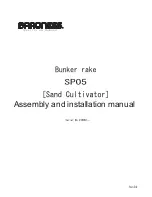
36
b. Open valve 2.
c. Turn on pumpout condenser water.
d. Run the pumpout compressor until the storage tank
pressure reaches 5 psig (34 kPa), 18 in. Hg vacuum
(41 kPa absolute) in Manual or Automatic mode.
e. Turn off the pumpout compressor.
f. Close valves 1a, 1b, 2, 5, and 6.
g. Turn off pumpout condenser water.
4. Drain the contaminants from the bottom of the storage
tank into a container. Dispose of contaminants safely.
GENERAL MAINTENANCE
Refrigerant Properties
The standard refrigerant for the 19MV chiller is HFC-134a/
R-513A. At normal atmospheric pressure, HFC-134a/R-513A
will boil at –14°F (–25°C)/-28°F (–33°C) and must, therefore, be
kept in pressurized containers or storage tanks. The refrigerant is
practically odorless when mixed with air and is noncombustible at
atmospheric pressure. Read the Material Safety Data Sheet and the
latest ASHRAE Safety Guide for Mechanical Refrigeration to
learn more about safe handling of this refrigerant.
Adding Refrigerant
Follow the procedures described in the Trim Refrigerant Charge
section, page 38.
Adjusting the Refrigerant Charge
If the addition or removal of refrigerant is required to improve
chiller performance, follow the procedures given under the Trim
Refrigerant Charge section, page 38.
Refrigerant Leak Testing
Because the refrigerant pressure is above atmospheric pressure at
room temperature, leak testing can be performed with refrigerant
in the chiller. Use an electronic halogen leak detector, soap bubble
solution, or ultrasonic leak detector. Ensure that the room is well
ventilated and free from concentration of refrigerant to keep false
readings to a minimum. Before making any necessary repairs to a
leak, transfer all refrigerant from the leaking vessel.
Leak Rate
It is recommended by ASHRAE that chillers be taken off line im-
mediately and repaired if the refrigerant leak rate for the entire
chiller is more than 10% of the operating refrigerant charge per
year.
Carrier recommends that leaks totaling less than the above rate but
more than a rate of 0.1% of the total charge per year should be re-
paired during annual maintenance or whenever the refrigerant is
transferred for other service work.
Test After Service, Repair, or Major Leak
If all the refrigerant has been lost or if the chiller has been opened
for service, the chiller or the affected vessels must be pressure test-
ed and leak tested. Refer to the Leak Test Chiller section on
page 18 to perform a leak test.
TESTING WITH REFRIGERANT TRACER
Use an environmentally acceptable refrigerant as a tracer for leak
test procedures. Use dry nitrogen to raise the machine pressure to
leak testing levels.
TESTING WITHOUT REFRIGERANT TRACER
Another method of leak testing is to pressurize with nitrogen only
and to use a soap bubble solution or an ultrasonic leak detector to
determine if leaks are present.
TO PRESSURIZE WITH DRY NITROGEN
NOTE: Pressurizing with dry nitrogen for leak testing should not
be done if the full refrigerant charge is in the vessel because purg-
ing the nitrogen is very difficult.
1. Connect a copper tube from the pressure regulator on the
cylinder to the refrigerant charging valve. Never apply full
cylinder pressure to the pressurizing line. Follow the listed
sequence.
2. Open the charging valve fully.
3. Slowly open the cylinder regulating valve.
4. Observe the pressure gage on the chiller and close the regu-
lating valve when the pressure reaches test level.
Do not
exceed
140 psig (965 kPa).
5. Close the charging valve on the chiller. Remove the cop-
per tube if it is no longer required.
Repair Leaks, Retest, Standing Vacuum Test
After pressurizing the chiller, test for leaks with a leak detector,
electronic halide leak detector, soap bubble solution, or ultrasonic
leak detector. Bring the chiller back to atmospheric pressure, re-
pair any leaks found, and retest.
After retesting and finding no leaks, apply a standing vacuum test.
Then dehydrate the chiller. Refer to the Standing Vacuum Test and
Chiller Dehydration sections (pages 20 and 21) in the Before Ini-
tial Start-Up section.
Checking Guide Vanes
During normal shutdown, when the chiller is off, the guide vanes
are closed. Complete the following steps to adjust position if re-
quired (see Fig. 36 and 37):
1. Remove the set screw in the guide vane coupling.
2. Loosen the holddown bolts on the guide vane actuator.
3. Pull the guide vane actuator away from the suction housing.
4. If required, rotate the guide vane shaft fully clockwise for
first stage and counterclockwise for second stage and spot-
drill the guide vane actuator shaft. Spot-drilling is neces-
sary when the guide vane actuator sprocket set screws on
the guide vane actuator shaft need to be re-seated.
(Remember: Spot-drill and tighten the first set screw
before spot-drilling for the second set screw.)
VALVE
1A
1B
2
3
4
5
6
7
10
11
CONDITION
C
C
C
C
VALVE
1A
1B
2
3
4
5
6
7
10
11
CONDITION
C
C
C
C
C
C
C
C
C
DANGER
HFC-134a/R-513A will dissolve oil and some non-metallic
materials, dry the skin, and, in heavy concentrations, may
displace enough oxygen to cause asphyxiation. When
handling this refrigerant, protect the hands and eyes and avoid
breathing fumes.
CAUTION
Always ensure to have water flow and lock out the
compressor when transferring refrigerant. Liquid refrigerant
may flash into a gas and cause possible freeze-up and
damage to the unit when the chiller pressure is below 35 psig
(241 kPa) for HFC R-134a or 39 psig (268 kPa) for R-513A.
WARNING
HFC-134a/HFO-513A should not be mixed with air or oxy-
gen and pressurized for leak testing. In general, this refriger-
ant should not be present with high concentrations of air or
oxygen above atmospheric pressures, because the mixture
can undergo combustion.
Summary of Contents for AquaEdge 19MV
Page 49: ...49 Fig 46 SIOB...
Page 50: ...50 Fig 47 IOB2...
Page 51: ...51 Fig 48 19MV Auxiliary Controls Wiring...
















































